Trade books support learning across the curriculum in classrooms at all grade levels. The books reviewed in this week’s column include recently published books that are strong choices for introducing units as well as for delving into topics and issues of interest. They enrich instruction, encourage discussion, and stimulate interest in further exploration through independent reading.
Ages 4–8
Don’t Let Them Disappear: 12 Endangered Species Across the Globe. Chelsea Clinton. Ill. Gianna Marino. 2019. Philomel/Penguin.
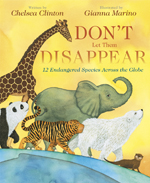 Through colorful, full-bleed, gouache paintings, this book introduces 12 animals (giraffes, gorillas, blue whales, rhinoceroses, giant pandas, whale sharks, polar bears, lions, sea otters, orangutans, tigers, and elephants) that are in danger of becoming extinct. A paragraph provides information about the characteristics and behavior of the featured animal, ending with “Don’t let them disappear!” as well as an inset listing range, endangered status, and why. Back matter includes additional information about reasons these animals are endangered, a “What Can You Do?” list things to do to help endangered species, and a list of 12 days of the year to celebrate such as Endangered Species Day (May 18) and World Rhino Day (September 22).
Through colorful, full-bleed, gouache paintings, this book introduces 12 animals (giraffes, gorillas, blue whales, rhinoceroses, giant pandas, whale sharks, polar bears, lions, sea otters, orangutans, tigers, and elephants) that are in danger of becoming extinct. A paragraph provides information about the characteristics and behavior of the featured animal, ending with “Don’t let them disappear!” as well as an inset listing range, endangered status, and why. Back matter includes additional information about reasons these animals are endangered, a “What Can You Do?” list things to do to help endangered species, and a list of 12 days of the year to celebrate such as Endangered Species Day (May 18) and World Rhino Day (September 22).
—CA
Home, Sweet Home: What Makes a House a Home? Moira Butterfield. Ill. Clair Rossiter. 2019. Kane Miller.
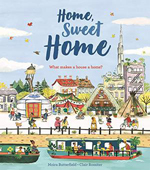 “The world is full of different homes, from tents and huts to bobbing boats, and apartments high up in the sky. What’s your home like?” Double-page spreads with colorful, richly detailed illustrations and accessible text invite readers to consider how the houses in which people live around the world today and in the past are similar and different to their own houses. The illustration on the final spread is the same as that on the first page but with the scene of different types of homes now filled with the people who live in them, which provides the perfect answer to the question as to what makes a house a home: “…it’s the people we love and share our homes with.”
“The world is full of different homes, from tents and huts to bobbing boats, and apartments high up in the sky. What’s your home like?” Double-page spreads with colorful, richly detailed illustrations and accessible text invite readers to consider how the houses in which people live around the world today and in the past are similar and different to their own houses. The illustration on the final spread is the same as that on the first page but with the scene of different types of homes now filled with the people who live in them, which provides the perfect answer to the question as to what makes a house a home: “…it’s the people we love and share our homes with.”
—CA
Riding a Donkey Backwards: Wise and Foolish Tales of Mulla Nasruddin. Sean Taylor & the Khayaal Theatre. Ill. Shirin Adl. 2019. Candlewick.
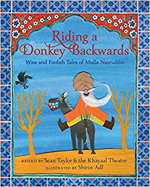 Master storyteller Sean Taylor teams up with the British Khayaal Theatre and British–Iranian illustrator Shirin Adl to present tales of the beloved trickster of Middle Eastern folklore, Mulla Nasruddin. The 21 short tales and vibrant mixed media illustrations in this collection will leave readers both laughing and thinking about the wisdom and foolishness so playfully imparted by Nasruddin, such as why he’s thankful after losing his donkey, and what he’d like to hear being said about him at his funeral. The book ends with Nasruddin answering the question as to why he rides his donkey backward and a glossary.
Master storyteller Sean Taylor teams up with the British Khayaal Theatre and British–Iranian illustrator Shirin Adl to present tales of the beloved trickster of Middle Eastern folklore, Mulla Nasruddin. The 21 short tales and vibrant mixed media illustrations in this collection will leave readers both laughing and thinking about the wisdom and foolishness so playfully imparted by Nasruddin, such as why he’s thankful after losing his donkey, and what he’d like to hear being said about him at his funeral. The book ends with Nasruddin answering the question as to why he rides his donkey backward and a glossary.
—CA
Spend It! (Moneybunny). Cinders McLeod. 2019. Nancy Paulsen/Penguin.
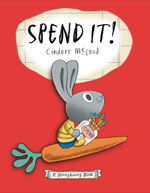 Every Saturday, Sonny earns three carrots. Of course, he wants to buy EVERYTHING (a toy rocket—2 carrots, a pogo stick—3 carrots, and a bouncy castle—100 carrots), but his allowance only goes so far. With a little advice from his mom about making choices, Sonny turns to math and logic for help. After he chooses the pogo stick, his mother declares, “Wow, Sonny! You’re getting good at this money stuff,” and he boings all over the page with glee. “Yes, I’m a smart spender! And I LOVE it!” Part of the Moneybunny series that teaches young children simple facts about money, Spend It!, with its colorful illustrations featuring an adorable bunny (drawn with pencil and then digitally colored), is sure to be worth every penny!
Every Saturday, Sonny earns three carrots. Of course, he wants to buy EVERYTHING (a toy rocket—2 carrots, a pogo stick—3 carrots, and a bouncy castle—100 carrots), but his allowance only goes so far. With a little advice from his mom about making choices, Sonny turns to math and logic for help. After he chooses the pogo stick, his mother declares, “Wow, Sonny! You’re getting good at this money stuff,” and he boings all over the page with glee. “Yes, I’m a smart spender! And I LOVE it!” Part of the Moneybunny series that teaches young children simple facts about money, Spend It!, with its colorful illustrations featuring an adorable bunny (drawn with pencil and then digitally colored), is sure to be worth every penny!
—NB
Ages 9–11
Flights of Fancy: Creative Inspiration from Ten Award-Winning Authors and Illustrators. 2019. Walker/Candlewick.
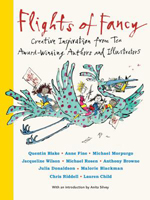 This anthology celebrating 20 years of the British Children’s Laureate program includes contributions by the 10 Laureates to date—Quentin Blake (the first Laureate from 1999–2001), Anne Fine, Michael Morpurgo, Jacqueline Wilson, Michael Rosen, Anthony Browne, Julia Donaldson, Malorie Blackman, Chris Riddell, and Lauren Child (the 2017–2019 Laureate)—that use a variety of formats including poems, short stories, and pictures to offer creative inspiration on writing and illustrating. Back matter includes a “20 Ideas for Creative Projects” section based on the Laureates’ tips and prompts and “More About the Laureates” biographical notes (including caricatures by Chris Riddell). Flights of Fancy is a valuable resource of inspiring activities as well as engaging introductions to the work of these award-winning British authors and illustrators.
This anthology celebrating 20 years of the British Children’s Laureate program includes contributions by the 10 Laureates to date—Quentin Blake (the first Laureate from 1999–2001), Anne Fine, Michael Morpurgo, Jacqueline Wilson, Michael Rosen, Anthony Browne, Julia Donaldson, Malorie Blackman, Chris Riddell, and Lauren Child (the 2017–2019 Laureate)—that use a variety of formats including poems, short stories, and pictures to offer creative inspiration on writing and illustrating. Back matter includes a “20 Ideas for Creative Projects” section based on the Laureates’ tips and prompts and “More About the Laureates” biographical notes (including caricatures by Chris Riddell). Flights of Fancy is a valuable resource of inspiring activities as well as engaging introductions to the work of these award-winning British authors and illustrators.
—CA
A Green Place to Be: The Creation of Central Park. Ashley Benham Yazdani. 2019. Candlewick.
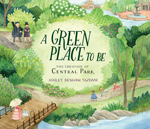 In 1858, New York City developed so quickly that forests and fields disappeared overnight as buildings and roads took over. The winning team of a design contest for the perfect park to be built in a deserted bog—architect Calvert Vaux (1822–1903) and Frederick Law Olmstead (1824–1895), the new park’s supervisor and landscape architect—created Central Park, “the green place to be” that people needed. Their design included parkland, ponds, a lake, walking paths, play areas, fountains, pagodas, entertainment venues, a Children’s District (with a petting zoo), and other features. The vibrant watercolor and pencil illustrations capture the details of the park with cartoon-like figures engaged in interesting activities. Back matter includes mini-biographies on Vaux and Olmstead, a trivia page with items to spot in the pictures (for example, people, buildings, 34 arches, trees, and a recurring squirrel), an author’s note, and a bibliography.
In 1858, New York City developed so quickly that forests and fields disappeared overnight as buildings and roads took over. The winning team of a design contest for the perfect park to be built in a deserted bog—architect Calvert Vaux (1822–1903) and Frederick Law Olmstead (1824–1895), the new park’s supervisor and landscape architect—created Central Park, “the green place to be” that people needed. Their design included parkland, ponds, a lake, walking paths, play areas, fountains, pagodas, entertainment venues, a Children’s District (with a petting zoo), and other features. The vibrant watercolor and pencil illustrations capture the details of the park with cartoon-like figures engaged in interesting activities. Back matter includes mini-biographies on Vaux and Olmstead, a trivia page with items to spot in the pictures (for example, people, buildings, 34 arches, trees, and a recurring squirrel), an author’s note, and a bibliography.
—NB
Hooray for Women! Marcia Williams. 2019. Candlewick.
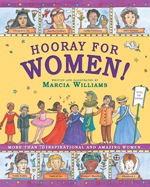 With her signature colorful, richly detailed comic book panels filled with facts, quotes, and witty conversations, Marcia Williams celebrates the accomplishments of inspirational women from around the world and throughout history. She presents comic-strip style profiles of 16 women chronologically from Queen of Egypt Cleopatra VII to children’s and women’s rights activist Malala Yousafzai, followed by three double-page spreads with thumbnail sketches of leaders, world changers, athletes, creatives, scientists, pioneers, and adventurers. Along the side borders, birds chirp comments about what’s happening in the panel and add facts, while two children (and a mouse) frolic across the bottom of the pages, adding their opinions and moving readers along to the next entry. Back matter includes a “Dear Reader” letter in which Williams talks about the difficulty she had in choosing her favorite inspirational women and challenges the reader to identify their own list and an index.
With her signature colorful, richly detailed comic book panels filled with facts, quotes, and witty conversations, Marcia Williams celebrates the accomplishments of inspirational women from around the world and throughout history. She presents comic-strip style profiles of 16 women chronologically from Queen of Egypt Cleopatra VII to children’s and women’s rights activist Malala Yousafzai, followed by three double-page spreads with thumbnail sketches of leaders, world changers, athletes, creatives, scientists, pioneers, and adventurers. Along the side borders, birds chirp comments about what’s happening in the panel and add facts, while two children (and a mouse) frolic across the bottom of the pages, adding their opinions and moving readers along to the next entry. Back matter includes a “Dear Reader” letter in which Williams talks about the difficulty she had in choosing her favorite inspirational women and challenges the reader to identify their own list and an index.
—CA
Ages 12–14
Beast Rider: A Boy’s Journey Across the Border. Tony Johnston & Marîa Elena Fontanot de Rhoads. 2019. Amulet/Abrams.
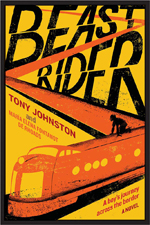 La Bestia, the train that travels between Mexico and the United States, is sometimes the only way that people can get from one country to another without papers. After his brother Toño hops on the beast to Los Angeles to begin a new life, 12-year-old Manuel Flores, who can’t stop thinking about him, decides to be a beast rider and leave his family of farmers to join him. This disturbing saga that takes place over three years begins with Manual’s almost immediate arrest by Mexican police, his being robbed, and, later, being brutalized by thugs on the trains. He also meets with kindness by people in most unlikely places. After Manual finally reunites with his brother, he learns something he didn’t realize about himself, which leads to a surprising decision. Back matter includes an author’s note about La Bestia and a glossary of Spanish terms.
La Bestia, the train that travels between Mexico and the United States, is sometimes the only way that people can get from one country to another without papers. After his brother Toño hops on the beast to Los Angeles to begin a new life, 12-year-old Manuel Flores, who can’t stop thinking about him, decides to be a beast rider and leave his family of farmers to join him. This disturbing saga that takes place over three years begins with Manual’s almost immediate arrest by Mexican police, his being robbed, and, later, being brutalized by thugs on the trains. He also meets with kindness by people in most unlikely places. After Manual finally reunites with his brother, he learns something he didn’t realize about himself, which leads to a surprising decision. Back matter includes an author’s note about La Bestia and a glossary of Spanish terms.
—NB
Crossing on Time: Steam Engines, Fast Ships, and a Journey to the New World. David Macaulay. 2019. Roaring Brook.
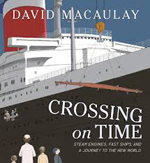 This fascinating story of the development of steam engines is told against the backdrop of David Macaulay’s personal narrative of his family’s trip across the ocean from England to the United States in 1957 at age 8, and concludes as his family settles into their new home in a New Jersey neighborhood, where this “foreign land became home.” Historical information is accompanied by detailed drawings and schematics of pumps and pistons, early steam engines, steam-powered paddleboats, river steamboats, compound engines, steam turbines, and the building of the SS United States (the ship the Macaulay family sailed on). Back matter includes an afterword with Macaulay’s nostalgic look at how his past has twined with transportation advances, a timeline (from 1497–2011) detailing pivotal events in the history of steam engines and transportation, and a reading list.
This fascinating story of the development of steam engines is told against the backdrop of David Macaulay’s personal narrative of his family’s trip across the ocean from England to the United States in 1957 at age 8, and concludes as his family settles into their new home in a New Jersey neighborhood, where this “foreign land became home.” Historical information is accompanied by detailed drawings and schematics of pumps and pistons, early steam engines, steam-powered paddleboats, river steamboats, compound engines, steam turbines, and the building of the SS United States (the ship the Macaulay family sailed on). Back matter includes an afterword with Macaulay’s nostalgic look at how his past has twined with transportation advances, a timeline (from 1497–2011) detailing pivotal events in the history of steam engines and transportation, and a reading list.
—NB
Ages 15+
The Magnificent Migration: On Safari with Africa’s Last Great Herds. Sy Montgomery. Ill. Roger Wood & Logan Wood. 2019. Houghton Mifflin.
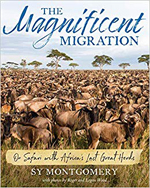 Readers join Sy Montgomery on the safari she took with Dr. Richard Estes, the leading expert on wildebeests, to study the antelope’s year-round clockwise migration of over 800 miles from Kenya’s Masai Mara south to Tanzania, west and north across the Serengeti Plains, and north to Kenya again, “the largest mass movement of animals on land.” Maps, numerous captioned full-color photographs, and brief biographies of the safari team complement the narrative. She also includes inserts on other “magnificent migrants”: Arctic terns, Christmas Island red crabs, loggerhead sea turtles, monarch butterflies, pilchard sardines, and zooplankton. In an epilogue, Montgomery addresses the endangered status of the wildebeest and the vulnerability of the Serengeti ecosystem. Back matter includes a bibliography, a “Get Involved” section, and an index.
Readers join Sy Montgomery on the safari she took with Dr. Richard Estes, the leading expert on wildebeests, to study the antelope’s year-round clockwise migration of over 800 miles from Kenya’s Masai Mara south to Tanzania, west and north across the Serengeti Plains, and north to Kenya again, “the largest mass movement of animals on land.” Maps, numerous captioned full-color photographs, and brief biographies of the safari team complement the narrative. She also includes inserts on other “magnificent migrants”: Arctic terns, Christmas Island red crabs, loggerhead sea turtles, monarch butterflies, pilchard sardines, and zooplankton. In an epilogue, Montgomery addresses the endangered status of the wildebeest and the vulnerability of the Serengeti ecosystem. Back matter includes a bibliography, a “Get Involved” section, and an index.
—CA
All Ages
You Are Home: An Ode to the National Parks. Evan Turk. 2019. Atheneum/Simon & Schuster.
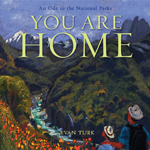 Evan Turk’s stunning landscapes, created with pastels on black paper, and the expressive lyrical text of his ode to the National Parks are both awe-inspiring and thought-provoking. The words “to the child whose / family has just / left its first footprints / on new shore; / to the child whose ancestors / lived on these lands before / the star and stripes / took them as their own / you are still home” beautifully express that the parks are home to everyone. In his author’s note, Turk considers the history of the National Parks as a symbol of our country’s best ideals and the importance of protecting the parks “under threat from so many pressures—pollution, climate change, and politics.” A map of the National Parks and a list of those shown in the book are included.
Evan Turk’s stunning landscapes, created with pastels on black paper, and the expressive lyrical text of his ode to the National Parks are both awe-inspiring and thought-provoking. The words “to the child whose / family has just / left its first footprints / on new shore; / to the child whose ancestors / lived on these lands before / the star and stripes / took them as their own / you are still home” beautifully express that the parks are home to everyone. In his author’s note, Turk considers the history of the National Parks as a symbol of our country’s best ideals and the importance of protecting the parks “under threat from so many pressures—pollution, climate change, and politics.” A map of the National Parks and a list of those shown in the book are included.
—CA
Nancy Brashear is Professor Emeritus of English, Azusa Pacific University, in Azusa, California. Carolyn Angus is former director of the George G. Stone Center for Children's Books, Claremont Graduate University, in Claremont, California.
These reviews are submitted by members of the International Literacy Association's Children's Literature and Reading Special Interest Group (CL/R SIG) and are published weekly on Literacy Daily.